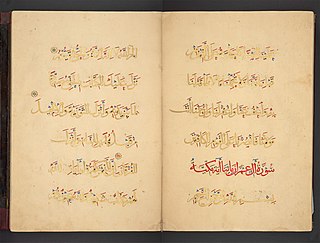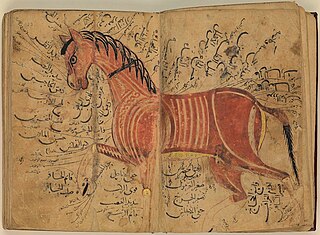Related Research Articles

Ibn Sina, commonly known in the West as Avicenna, was a Persian polymath who is regarded as one of the most significant physicians, astronomers, philosophers, and writers of the Islamic Golden Age, and the father of early modern medicine. Sajjad H. Rizvi has called Avicenna "arguably the most influential philosopher of the pre-modern era". He was a Muslim Peripatetic philosopher influenced by Greek Aristotelian philosophy. Of the 450 works he is believed to have written, around 240 have survived, including 150 on philosophy and 40 on medicine.

Ḥasan Ibn al-Haytham, Latinized as Alhazen, was a medieval mathematician, astronomer, and physicist of the Islamic Golden Age from present-day Iraq. Referred to as "the father of modern optics", he made significant contributions to the principles of optics and visual perception in particular. His most influential work is titled Kitāb al-Manāẓir, written during 1011–1021, which survived in a Latin edition. The works of Alhazen were frequently cited during the scientific revolution by Isaac Newton, Johannes Kepler, Christiaan Huygens, and Galileo Galilei.

The Almoravid dynasty was an imperial Berber Muslim dynasty centered in the territory of present-day Morocco. It established an empire in the 11th century that stretched over the western Maghreb and Al-Andalus, starting in the 1050s and lasting until its fall to the Almohads in 1147. The Almoravid capital was Marrakesh, a city founded by the Almoravid leader Abu Bakr ibn Umar c. 1070. The dynasty emerged from a coalition of the Lamtuna, Gudala, and Massufa, nomadic Berber tribes living in what is now Mauritania and the Western Sahara, traversing the territory between the Draa, the Niger, and the Senegal rivers.

Abū Mūsā Jābir ibn Ḥayyān, died c. 806−816, is the purported author of an enormous number and variety of works in Arabic, often called the Jabirian corpus. The works that survive today mainly deal with alchemy and chemistry, magic, and Shi'ite religious philosophy. However, the original scope of the corpus was vast and diverse, covering a wide range of topics ranging from cosmology, astronomy and astrology, over medicine, pharmacology, zoology and botany, to metaphysics, logic, and grammar.

The Hermetica are texts attributed to the legendary Hellenistic figure Hermes Trismegistus, a syncretic combination of the Greek god Hermes and the Egyptian god Thoth. These texts may vary widely in content and purpose, but are usually subdivided into two main categories, the "technical" and "religio-philosophical" Hermetica.

Abū al-ʿAbbās Aḥmad ibn Muḥammad ibn Kathīr al-Farghānī also known as Alfraganus in the West, was a Persian astronomer in the Abbasid court in Baghdad, and one of the most famous astronomers in the 9th century. Al-Farghani composed several works on astronomy and astronomical equipment that were widely distributed in Arabic and Latin and were influential to many scientists. His best known work, Kitāb fī Jawāmiʿ ʿIlm al-Nujūmi, was an extensive summary of Ptolemy's Almagest containing revised and more accurate experimental data. Christopher Columbus, used Al Farghani’s calculations for his voyages to America. In addition to making substantial contributions to astronomy, al-Farghani also worked as an engineer, supervising construction projects on rivers in Cairo, Egypt. The lunar crater Alfraganus is named after him.

Constantine the African was a physician who lived in the 11th century. The first part of his life was spent in Ifriqiya and the rest in Italy. He first arrived in Italy in the coastal town of Salerno, home of the Schola Medica Salernitana, where his work attracted attention from the local Lombard and Norman rulers. Constantine then became a Benedictine monk, living the last decades of his life at the abbey of Monte Cassino.

Isaac Israeli ben Solomon, also known as Isaac Israeli the Elder and Isaac Judaeus, was one of the foremost Jewish physicians and philosophers living in the Arab world of his time. He is regarded as the father of medieval Jewish Neoplatonism. His works, all written in Arabic and subsequently translated into Hebrew, Latin and Spanish, entered the medical curriculum of the early thirteenth-century universities in Medieval Europe and remained popular throughout the Middle Ages.

Al Imran (Arabic: آلِ عِمرَان, āl ʿimrān; meaning: The Family of Imran is the third chapter of the Quran with two hundred verses.

The Secretum or Secreta Secretorum, also known as the Sirr al-Asrar, is a pseudo-Aristotelian treatise which purports to be a letter from Aristotle to his student Alexander the Great on an encyclopedic range of topics, including statecraft, ethics, physiognomy, astrology, alchemy, magic, and medicine. The earliest extant editions claim to be based on a 9th-century Arabic translation of a Syriac translation of the lost Greek original. Modern scholarship finds it likely to have been a 10th-century work composed in Arabic. Translated into Latin in the mid-12th century, it was influential among European intellectuals during the High Middle Ages.
Abu-Abdullah Muhammad ibn Īsa Māhānī was a Persian mathematician and astronomer born in Mahan, and active in Baghdad, Abbasid Caliphate. His known mathematical works included his commentaries on Euclid's Elements, Archimedes' On the Sphere and Cylinder and Menelaus' Sphaerica, as well as two independent treatises. He unsuccessfully tried to solve a problem posed by Archimedes of cutting a sphere into two volumes of a given ratio, which was later solved by 10th century mathematician Abū Ja'far al-Khāzin. His only known surviving work on astronomy was on the calculation of azimuths. He was also known to make astronomical observations, and claimed his estimates of the start times of three consecutive lunar eclipses were accurate to within half an hour.

The three brothers Abū Jaʿfar, Muḥammad ibn Mūsā ibn Shākir ; Abū al‐Qāsim, Aḥmad ibn Mūsā ibn Shākir and Al-Ḥasan ibn Mūsā ibn Shākir, known as the Banū Mūsā, were Persian scholars, who lived and worked in Baghdad.

Latin translations of the 12th century were spurred by a major search by European scholars for new learning unavailable in western Europe at the time; their search led them to areas of southern Europe, particularly in central Spain and Sicily, which recently had come under Christian rule following their reconquest in the late 11th century. These areas had been under Muslim rule for a considerable time, and still had substantial Arabic-speaking populations to support their search. The combination of this accumulated knowledge and the substantial numbers of Arabic-speaking scholars there made these areas intellectually attractive, as well as culturally and politically accessible to Latin scholars. A typical story is that of Gerard of Cremona, who is said to have made his way to Toledo, well after its reconquest by Christians in 1085, because he
arrived at a knowledge of each part of [philosophy] according to the study of the Latins, nevertheless, because of his love for the Almagest, which he did not find at all amongst the Latins, he made his way to Toledo, where seeing an abundance of books in Arabic on every subject, and pitying the poverty he had experienced among the Latins concerning these subjects, out of his desire to translate he thoroughly learnt the Arabic language....
Khālid ibn Yazīd, c. 668–704 or 709, was an Umayyad prince and purported alchemist.
Abu Imran Musa ibn Isa ibn abi hajjal-Fasi was a Moroccan Maliki faqīh born at Fez to a Berber or Arab family whose nisba is impossible to reconstruct.

Furūsiyya is the historical Arabic term for equestrian martial exercise. Furūsiyya “Knighthood” is a martial tradition dating back to Pre-Islamic Arabia
Abū aṣ‐Ṣalt Umayya ibn ʿAbd al‐ʿAzīz ibn Abī aṣ‐Ṣalt ad‐Dānī al‐Andalusī, known in Latin as Albuzale, was an Andalusian-Arab polymath who wrote about pharmacology, geometry, Aristotelian physics, and astronomy. His works on astronomical instruments were read both in the Islamic world and Europe. He also occasionally traveled to Palermo and worked in the court of Roger I of Sicily as a visiting physician. He became well known in Europe through translations of his works made in the Iberian Peninsula and in southern France. He is also credited with introducing Andalusi music to Tunis, which later led to the development of the Tunisian ma'luf.
Abu Dawud Sulayman ibn Hassan Ibn Juljul was an influential Andalusian Arab physician and pharmacologist of perhaps Spanish extraction. He wrote an important book on the history of medicine. His works on pharmacology were frequently quoted by physicians in Al-Andalus during the 10th and 11th centuries. Some of his works were later studied by Albertus Magnus, like De secretis, but were attributed to a Latinized version of his name, Gilgil.
ʻAfīf al-Dīn ʻAlī ibn ʻAdlān al-Mawsilī, born in Mosul, was an Arab cryptologist, linguist and poet who is known for his early contributions to cryptanalysis, to which he dedicated at least two books. He was also involved in literature and poetry, and taught on the Arabic language at the Al-Salihiyya Mosque of Cairo.
The 1465 Moroccan revolution was a popular uprising in the city of Fez—then capital of Morocco—against Sultan Abd al-Haqq II, the last ruler of the Marinid dynasty, and his Jewish vizier Harun ibn Batash.
References
- ↑ Horden, Peregrine (2017). Music as Medicine: The History of Music Therapy Since Antiquity. Routledge. ISBN 9781351557474.
- ↑ Adel Omrani et al, Ibn Imran's 10th century Treatise on Melancholy, Journal of Affective Disorders 141 (2012), pp.116-9.
- ↑ Angus Gowland, Burton's Anatomy and the Intellectual Traditions of Melancholy, Revue Babel 25 (2012), pp.221-57.